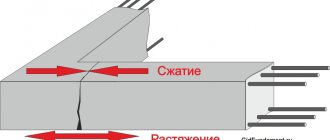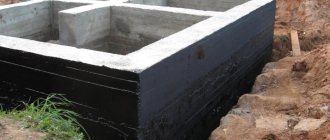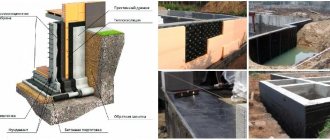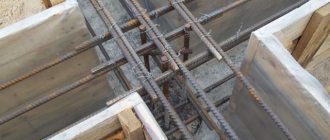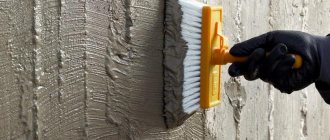Waterproofing work is an important stage in the construction of a building, since concrete structures tend to absorb moisture due to their porous structure.
To prevent the capillary effect, in which moisture spontaneously rises up the walls under the influence of surface tension forces, it is necessary to pay due attention to the horizontal waterproofing of the foundation.
Application
This type of waterproofing is used in the construction of buildings for various purposes :
- private houses,
- garages,
- commercial and industrial buildings.
It is used in regions with varied climatic conditions, even in areas where the annual level of precipitation is quite low.
The fact is that the foundation is exposed not only to storm water, but also to groundwater. Due to frequent contact with liquid, not only the gradual destruction of concrete occurs, but also corrosion of the steel reinforcement that is used in the construction of the reinforced concrete base and its base.
Horizontal waterproofing is also necessary in the following cases:
if the concrete used in the construction of the foundation does not contain hydrophobic additives and has insufficient water-repellent properties;- when the groundwater level is located at a depth of less than 1 meter under the base of the concrete foundation;
- if the foundation of the building is constantly in contact with water: for example, if the building is built on the banks of a river, lake or other body of water.
Methods for waterproofing foundations
An example of cement-based plaster waterproofing.
The type and type of protection are provided at the design stage of the structure. In this case, the humidity conditions of the premises are taken into account. Under normal conditions, in accordance with SNiP II-3-79, humidity is limited to 75%. Rooms in which this characteristic does not exceed 60% are considered dry.
Capillary movement of water directly affects the humidity of rooms. The height of liquid rise through the micropores of concrete or brick walls depends on the density of the soil and can reach:
Waterproofing of pile-grillage foundations
- 1.1 m if the foundation is located on sand;
- 12–25 m if the soil is clayey or silty.
Foundations for low-rise construction of all types, regardless of the method of burial, have an upper flat surface: a grillage in pile foundations, a strip or slab in others. In all cases, the horizontal waterproofing mark should be half a meter above the maximum possible groundwater level.
The following types of waterproofing are distinguished:
- painting - a continuous multi-layer coating of bitumen or polymer-bitumen compositions;
- plastering with cement compositions;
- plastering with bitumen mixtures;
- lining - a carpet made of rolled materials - roofing felt or synthetic films;
- facing – fencing made of steel or polymer sheets that are welded (glued) into a single deck.
What materials are used?
According to the requirements of regulatory documents GOST 32384-2008 and SNiP 2.03.11-85 as amended in 2022, secondary horizontal waterproofing of foundations is created based on the following materials:
- Paint and varnish coatings . As such, special paints are used that use a bitumen or bitumen-polymer base.
- Insulating compounds . This category includes adhesive and weld-on coatings (rolled), special types of facing tiles, as well as membrane products.
- Impregnating mixtures . Such products have moisture-repellent and pore-sealing characteristics. Cement with various modifiers, as well as polymer-cement mixtures with high penetrating ability can be used as a base.
The most popular and widespread are materials of the second type. Roll and coating waterproofing is characterized by ease of application, a long service life and good water-repellent properties.
As an alternative, bridging compounds are often used . Their key feature is the ability to fill microscopic pores in the concrete structure.
The composition of such products includes special finely ground substances (for example, bitumen or cement dust), which are dissolved in water and applied to the surface to be treated, after which they penetrate the pores, harden and block the capillary channels.
Restoration of horizontal waterproofing
If at the construction stage the horizontal cut-off waterproofing between the wall and the foundation was not made or was made with violations, then its restoration after the walls have been erected is possible only with the use of injection waterproofing.
When injecting from inside a constructed basement, plinth or other room, the polyurethane injection resin under pressure penetrates into the space between the foundation and the constructed wall, thereby restoring horizontal waterproofing, which also serves as a cutoff preventing water and moisture from rising capillarily up the wall.
Waterproofing restoration technology on the horizon using injection:
- Dismantling of finishing elements that interfere with reaching the base of the cold seam of the slab-to-wall junction. Such elements can be tiles, screed, drywall and plaster on the inside walls of the basement;
- Installation of a small fine at the junction of the wall and the foundation surface;
- Layer-by-layer compaction of expanding sealant into the made groove. This procedure is necessary so that when polyurethane resin is injected into a seam, the composition spreads horizontally into the wall itself, and does not come out back through a weak joint;
- Drilling holes at an angle of 45 degrees to the center of the cold seam or the junction of the foundation and the wall;
- Installation of injectors or packers into drilled holes;
- Connecting the injection pump to the installed packers and injecting the injection composition;
- Dismantling of installed packers and sealing the holes with a special expanding sealant;
Detailed recovery scheme:
Scheme for restoring horizontal waterproofing using the injection method
Application technologies
Waterproofing coatings are applied to foundation surfaces in two main ways: cold and hot .
The cold method is used when working with ready-made bitumen mixtures or materials that require additional dilution.
The main advantage of this technology is the high speed and safety of waterproofing work. When applying waterproofing layers cold, there is no need to use additional thermal equipment, when working with which you must follow certain safety rules.
Materials are applied with ordinary brushes, rollers, spatulas and similar tools.
Hot technology involves heating rolled, solid or powdered material to a high temperature at which it melts. Molten bitumen is applied to the surface to be treated using tools equipped with elongated holders (to protect against accidental burns).
If sheet material is used, it is heated in small sections using gas burners and the heated fragments are immediately rolled out along the horizontal surfaces of the foundation.
Rolled and pasted
Roll and sheet waterproofing coatings are installed in two ways: with heating and by gluing.
The second option involves the use of additional adhesive mixtures (liquid bitumen mastic can be used as such) or self-adhesive layers.
Before applying roll and adhesive waterproofing, it is recommended to treat the surface with a primer or bitumen primer . This will achieve better adhesion and prevent premature decline in the performance properties of the material.
Penetrating method
To construct penetrating waterproofing, cement mortars containing modifying chemical additives are used.
The technology includes the following stages:
- the surface of the foundation is thoroughly cleaned to remove possible contamination and to open existing pores and cracks;
- the cement composition is mixed with modifiers (if they are not initially included in the material) and diluted with water to the optimal consistency;
- then the surface to be treated is moistened with clean water to improve adhesion;
- the final stage is the application of waterproofing material using a spatula;
- then the protective layer is left until completely dry, which takes several days.
Injection method
This method involves the introduction of waterproofing material into the foundation structure by injection. The bottom line is this: horizontal or inclined holes are drilled in the walls of a concrete structure in small increments.
Special attachments - parkers - are inserted into the prepared holes. They are necessary for uniform distribution of waterproofing material throughout the entire volume of the concrete structure. A composite mortar is then injected into the parkers to provide waterproofing.
Low pressure pumps (no more than 4 atm) are used to supply it, since too powerful pumping equipment can destroy the internal structure of concrete.
Moisture insulation of formwork
To answer the question whether waterproofing is needed for formwork or not, let’s consider its main functions. The design is designed to limit the space into which the concrete solution will be poured to form the foundation. In other words, the main function of formwork is to form a liquid solution, which, when hardened, forms the necessary geometric shape.
Waterproofing strip foundation formwork
To assemble the formwork, as a rule, wooden panels are used, which are hygroscopic. Because of this, structural elements may be deformed, which will lead to distortion of the geometric shapes of the poured concrete base. In this case, the answer to the above question becomes obvious: waterproofing for formwork is really necessary.
What types of insulators are used for finishing formwork? To protect wooden formwork elements the following can be used:
- bitumen solutions;
- hydrophobic impregnations;
- water-repellent varnishes;
- roll insulators.
When calculating the amount of waterproofing materials used, it is worth noting that for formwork processing, painting with bitumen will be the most cost-effective option.
Features for different types of foundations
Methods for arranging waterproofing coatings are selected taking into account the design features of foundations:
Tape-type structures are treated with all the methods listed above: pasting, penetrating and injection waterproofing.
Such foundations are very easy to process, so the choice of a specific waterproofing option depends solely on the owner of the building.- When processing pile foundations, it is necessary to take into account the type of material from which the base is composed.
If reinforced concrete piles are used, they are treated on the outside with coating waterproofing mixtures. If metal piles made from hollow steel pipes are used, they must be treated on both sides. Their internal volume is filled with concrete with hydrophobic impurities, and the outer surfaces are covered with bitumen mastic. - If the foundation consists of a monolithic reinforced concrete slab , the work must be carried out in two stages.
At the first stage, it is necessary to equip a drainage system and create blind areas that will prevent groundwater from penetrating into the soil layers in direct contact with the foundation. The second stage is waterproofing treatment of the foundation structure. As a rule, coating materials are used for this: for example, bitumen mastic. The use of rolled products is also allowed.
Protection of foundations from soil water
Scheme of waterproofing a foundation with a basement.
The work can be done with your own hands. In this case, certain features should be taken into account. Types of wall waterproofing, technology for applying protective layers, their density and thickness depend not only on the saturation of the soil with soil water, but also on the aggressiveness of the environment. Moisture may contain salts with various acidic residues; active chemicals of technical origin and natural reagents may be dissolved in it. Some compounds are capable of destroying Portland cement, others - metal reinforcement, and still others - bitumen-containing coatings.
Types of foundations and construction procedures, types of foundation waterproofing are regulated by State Standards (GOST) and Construction Norms and Rules (SNiP). In general terms, these issues are grouped and set out in the Recommendations for the design of waterproofing of underground parts of buildings and structures, published by the Central Research Institute of Industrial Buildings in 1996. According to regulatory technical documents, pressure and filtration types of water loads on the walls of structures are distinguished.
Cost of construction work
The costs of waterproofing work are determined taking into account several factors:
- Material type . The cheapest are rolled welded products. Their cost varies from 25 to 60 rubles per square meter. Coating protective coatings are several times more expensive, but provide a higher degree of waterproofing. Their average market price is 100-150 rubles/kg, depending on the composition. Materials based on chemical solvents cost 60-100 rubles/kg, and water-based materials cost 150-200 rubles/kg.
- Number of layers . When using materials that are applied using the cold laying method, the average consumption is about 1-1.5 kg/m2 per layer. If you use budget hot-applied waterproofing, which costs about 60 rubles/kg, with a two-layer treatment the cost of each square meter will be 120-180 rubles/m2, excluding the cost of construction services. If we take into account the costs of waterproofing work, the price will reach 500-600 rubles/m2.
Everything you need to know about foundation waterproofing can be found in this section.
Blind area device
Do-it-yourself foundation waterproofing in this case involves using the following blind area materials to protect the structure from the outside from atmospheric moisture:
Making a blind area
- concrete;
- asphalt concrete;
- clay;
- paving slabs;
- diffusion membranes.
The choice of method for making a blind area depends on the preferences of the future owner of the house, the architectural design and the availability of materials. The cheapest option for a blind area would be to lay it out of concrete or asphalt. This option does not have an attractive appearance, but it allows you to protect the foundation without much labor. In addition, savings are achieved on raw materials for manufacturing. The construction of a blind area made of concrete or asphalt is popular in the mass construction of multi-apartment residential buildings and administrative and public buildings.
Supporting Features
By introducing additional components into the gel, the following properties are achieved:
- fungus removal;
- mold control;
- improving chemical protection of buildings;
- reducing the risk of reinforcement corrosion.
Reviews
According to most experts, injection waterproofing should be used using a special technology.
- First, holes are drilled for it at a distance of 0.5 m from each other with a diameter of 1 or 2 cm. A hammer drill is already needed here.
- Also, the holes must be through for high-quality waterproofing. And for repairing small cracks and crevices, blind holes.
- The holes are pre-moistened with water if a hydro-reactive injection composition is used.
- Next, you should pump the injection into the drilled holes.
- If desired, you can do work to protect against fungus or mold.
- Finally, you need to cover the work surface with plaster. After drying, you will get high-quality water protection for many years.
Process
Injection waterproofing technology occurs in the following steps:
- First, we study the surface, where and in what places we want to inject.
- Then we drill small (20 mm in diameter) through holes along the wall in increments of 0.25–0.5 m.
- Next, holes of the same diameter are drilled along the crack.
- At the next step, metal or polymer tubes (fittings) are inserted into the holes, and valves are attached to the other end.
- A tank with an injection solution is connected to the ends of the valves. Due to the increase in pressure in the tank, the solution is transported through the tube behind the wall.
- When the solution hardens, the tubes are removed from the wall and the outer surface is treated with moisture-resistant plaster.
This technology can only be provided by companies with special equipment. Such equipment is not cheap. Therefore, for high-quality injection waterproofing, it is better to contact such companies.
It is also worth mentioning that such work is not recommended to be carried out at temperatures of 5 degrees Celsius and below. This is due to the fact that the solution hardens more slowly and becomes of less quality at this temperature.
Varieties of cement-based moisture-proofing compounds ↑
Based on their intended purpose, mixtures are divided into several types:
- Coating insulation is a standard and inexpensive mixture for protecting non-deformable surfaces from moisture. Widely used: protection from moisture of foundations and plinths of buildings, both external and internal. Waterproofing of floors, swimming pools and water tanks. Treatment of slabs of balconies and exploited terraces. Apply to concrete, cement screeds, brick, plasterboard, other mineral surfaces, metal, wood. Coating waterproofing is sometimes called plaster, which is incorrect.
Advantages
Injection waterproofing has special advantages over its analogues.
- Saves time. Injection can be carried out both after completion and during construction.
- Saves finances. High-quality waterproofing lasts a very long time and does not require frequent repairs.
- Solves most leakage problems.
- The injected material is able to penetrate even the smallest pores and cavities.
- It has a high quality waterproofing membrane.
- A high-quality seamless waterproofing coating is created.
- This waterproofing is safe for drinking water.
- The hardening time with a certain composition reaches a couple of seconds.
However, due to the difficult work of injection waterproofing, which thickens very quickly, specialists are needed for it. Therefore, this method is not found in the list of services of every construction company.
Flaws
This method has the following disadvantages:
- Expensive materials and equipment.
- Specialists are needed for quality work.
However, these disadvantages are quickly compensated by the excellent quality and speed of work.
